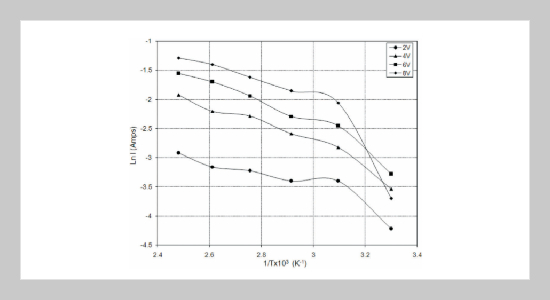REFERENCES
- [1] Grozdanov, I. and Najdoski, M., “Optical and Electrical Properties of Copper Sulphide Films of Variable Composition,” Journal of Solid State Chemistry, Vol. 114, pp. 469�475 (1995).
- [2] Sagade, A. A. and Sharma, R., “Copper Sulphide (CuxS) as an Ammonia Gas Working at Room Temperature,” Sensors and Actuators B: Chemical, Vol. 133, pp. 135�143 (2008).
- [3] Thongtem, T., Phuruangrat, A. and Thongtem, S., “Characterization of Copper Sulphide Nanostructured Spheres and Nanotubes Synthesized by Microwave Assisted Solvo Thermal Method,” Materials Letters, Vol. 64, pp. 136�139 (2010).
- [4] Yu, X. and An, X., “Controllable Hydrothermal Synthesis of Cu2S Nanowires on the Copper Substrate,” Materials Letters, Vol. 64, pp. 252�254 (2010).
- [5] Zhang, Y. C., Qiao, T. and Hu, X. Y., “A Simple Hydrothermal Route to Nanocrystalline CuS,” Journal of Crystal Growth, Vol. 268, pp. 64�70 (2004).
- [6] Li, F., Wu, J. F., Qin, Q., Li, Z. and Huang, X., “Controllable Synthesis, Optical and Photo Catalytic Properties of CuS Nanomaterials with Hierarchial Structures,” Powder Technology, Vol. 189, pp. 267�274 (2010).
- [7] Ashour, A., “The Physical Characteristics of Cu2S/ CuS Thin Film Solar Cell,” Journal of Optoelectronics and Advanced Materials, Vol. 8, pp. 1447�1451 (2006).
- [8] Wang, S. Y., Wang, W. and Lu, Z. H., “Asynchronous Pulse Ultrasonic Spray Pyrolysis Deposition of CuXS (X-1,2) Thin Films,” Material Science and Engineering: B, Vol. 103, pp. 184�188 (2003).
- [9] Pathan, H. M., Desai, J. D. and Lokhande, C. D., “Modified Chemical Deposition and Physio-Chemical Properties of Copper Sulphide (Cu2S) Thin Films,” Applied Surface Science, Vol. 202, pp. 47�56 (2002).
- [10] Podder, J., Kobayashi, R. and Ichimura, M., “Photochemical Deposition of CuXS Thin Films from Aqueous Solutions,” Thin Solid Films, Vol. 472, pp. 71�75 (2005).
- [11] Ramya, M. and Ganesan, S., “Study of Thickness Dependent Characteristics of Cu2S Thin Films for Various Applications,” Iranian Journal of Material Science and Engineering, Vol. 8, pp. 34�40 (2011).
- [12] Mazumdar, N., Sarma, R., Sarma, B. K. and Das, H. L., “Photoconductivity of ZnTe Thin Films at Elevated Temperatures,” Bulletin of Material Sciences, Vol. 29, pp. 11�14 (2006).
- [13] Gould, R. D. and Ismail, B. B., “Poole-Frenkel Conductivity in Evaporated CdTe Thin Films with PbCl2,” Vacuum, Vol. 50, pp. 99�101 (1998).
- [14] Babkir, S. S., Ansari, A. A. and Al-Twarqi, N. M., “Activation Energy and Density of States of CdTe Thin Films from Temperature Dependent I-V Measurements,” Materials Chemistry and Physics, Vol. 127, pp. 296�299 (2011).
- [15] Gogai, S. and Barua, K., “D.C Electrical Properties of Vacuum Deposited CdTe Films,” Thin Solid Films, Vol. 239, pp. 205�210 (1999).
- [16] Sathyamoorthy, R., Sharmila, C., Sudhagar, P., Chandramohan, C. and Velumani, S., “Electrical Conduction in Zinc Phosphide Thin Films,” Materials Characterization, Vol. 58, pp. 730�734 (2007).
- [17] El-Samanoudy, M. M., “Modified Poole-Frenkel Mecahnisms in Ge25BixSb15-xS60 Thin Films,” Applied Surface Science, Vol. 207, pp. 219�226 (2003).
- [18] Kalita, P. K. R., Sarma, B. K. and Das, H. L.,“Space Charge Limited Conduction in CdSe Thin Films,” Bulletin of Material Sciences, Vol. 26, pp. 613�617 (2003).
- [19] Yildirim, S., Ulutas, K., Deger, D., Zayim, E. O. and Turhan, I., “Dielectric Properties of Sol-Gel Derived Ta2O5 Thin Films,” Vacuum, Vol. 77, pp. 329�335 (2005).
- [20] Mott, N. F., Proc. R. Soc., London, Vol. 171, p. 27 (1937).
- [21] Schottky, W., Z. Phys., Vol. 118, p. 539 (1942).
- [22] Nandi, S. K., Chaterjee, S., Samanta, S. S., Dalpati, G. K., Bose, P. K., Varma, S., Patil, S. and Maiti, C. K., “Electrical Properties of Ta2O5 Films Deposited on ZnO,” Bulletin of Material Sciences, Vol. 26, pp. 365�369 (2003).
- [23] Maissel, L. I. and Glang, R., Hand Book of Thin Film Technology, Mc-Graw Hill Book Company, New York (1970).
- [24] Lokhande, C. D., Pathan, H. M., Giersig, M. and Tributsch, H., “Preparation of Znx(O,S)y Thin Films Using Modified Chemical Bath Deposition Method,” Applied Surface Science, Vol.187, pp. 101�107 (2002).
- [25] Ubale, A. U., Choudhari, D. M., Kantale, J. S., Mitkari, V. N., Nikam, M. S., Gawande, W. J. and Patil, P. P., “Synthesis of Nanostructured Thin Films by Chemical Route at Room Temperature and Investigation of Their Size Dependent Physical Properties,” Journal of Alloy and Compounds, Vol. 509, pp. 9249�9254 (2011).
- [26] Ramya, M. and Ganesan, S., “Annealing Effects on Resistivity Properties of Vacuum Evaporated Cu2S Thin Films,” International Journal of Pure and Applied Physics, Vol. 3, pp. 243�249 (2010).
- [27] Ghosh, P. K., Jana, S., Nandy, S. and Chattopadhyay, K. K., “Size-Dependent Optical and Dielectric Properties of Nanocrystalline ZnS Thin Films Synthesized via rf-Magnetron Sputtering Technique,” Materials Research Bulletin, Vol. 42, pp. 505�514 (2007).
- [28] Ravinder, D. and Kumar, K. V., “Dielectric Behaviour of Erbium Substituted Mn-Zn Ferrites,” Bulletin of Material Sciences, Vol. 24, pp. 505�509 (2001).
- [29] Ambily, S., Xavier, F. P. and Menon, C. S., “Photoconductivity Measurements in Lead Pthalocyanine Thin Films,” Materials Letter, Vol. 41, pp. 5�8 (1999).
- [30] Gill, W. D. and Rube, R. H., “Photovoltaic Properties of Cu2S/CdS Heterojunctions,” Journal of Applied Physics, Vol. 41, pp. 3731�3738 (1970).
















